MCP: Multi-Chicken Pose Estimation Based on Transfer Learning
Abstract
Simple Summary
Abstract
1. Introduction
2. Materials and Methods
2.1. Experimental Environment
2.2. Data Preprocessing
2.3. Top-Down and Bottom-Up Mode
2.4. The Basic Structure of MCP Algorithms
2.4.1. The Basic Structure of the MCP Algorithms
2.4.2. Single-Chicken Pose Estimation
2.5. Evaluation Metrics
3. Results and Discussion
3.1. Experimental Setting
3.2. Experimental Results
4. Conclusions
Author Contributions
Funding
Institutional Review Board Statement
Informed Consent Statement
Data Availability Statement
Acknowledgments
Conflicts of Interest
References
- Chen, S.; Luo, S.; Yan, C. Gut microbiota implications for health and welfare in farm animals: A review. Animals 2022, 12, 93. [Google Scholar] [CrossRef] [PubMed]
- Schütz, A.K.; Krause, E.T.; Fischer, M.; Müller, T.; Freuling, C.M.; Conraths, F.J.; Homeier-Bachmann, T.; Lentz, H.H.K. Computer vision for detection of body posture and behavior of red foxes. Animals 2022, 12, 233. [Google Scholar] [CrossRef] [PubMed]
- Bao, J.; Xie, Q. Artificial intelligence in animal farming: A systematic literature review. J. Clean. Prod. 2022, 331, 129956. [Google Scholar] [CrossRef]
- Stadig, L.M.; Rodenburg, T.B.; Ampe, B.; Reubens, B.; Tuyttens, F.A.M. An automated positioning system for monitoring chickens’ location: Effects of wearing a backpack on behaviour, leg health and production. Appl. Anim. Behav. Sci. 2018, 198, 83–88. [Google Scholar] [CrossRef]
- Lei, K.; Zong, C.; Yang, T.; Peng, S.; Zhu, P.; Wang, H.; Teng, G.; Du, X. Detection and analysis of sow targets based on image vision. Agriculture 2022, 12, 73. [Google Scholar] [CrossRef]
- Wu, X.; Wang, Y.; Chen, L.; Zhang, L.; Wang, L. Motion parameters measurement of user-defined key points using 3d pose estimation. Eng. Appl. Artif. Intell. 2022, 110, 104667. [Google Scholar] [CrossRef]
- Simitzis, P.; Tzanidakis, C.; Tzamaloukas, O.; Sossidou, E. Contribution of precision livestock farming systems to the improvement of welfare status and productivity of dairy animals. Dairy 2022, 3, 12–28. [Google Scholar] [CrossRef]
- Fang, C.; Zheng, H.; Yang, J.; Deng, H.; Zhang, T. Study on Poultry Pose Estimation Based on Multi-Parts Detection. Animals 2022, 12, 1322. [Google Scholar] [CrossRef] [PubMed]
- Ballesta, S.; Reymond, G.; Pozzobon, M.; Duhamel, J.R. A real-time 3d video tracking system for monitoring primate groups. J. Neurosci. Methods 2014, 234, 147–152. [Google Scholar] [CrossRef] [PubMed]
- Andriluka, M.; Roth, S.; Schiele, B. Pictorial Structures Revisited: People Detection and Articulated Pose Estimation; IEEE: New York, NY, USA, 2009. [Google Scholar]
- Serre, T. Deep learning: The good, the bad, and the ugly. Annu. Rev. Vis. Sci. 2019, 5, 399–426. [Google Scholar] [CrossRef] [PubMed]
- Zheng, C.; Wu, W.; Chen, C.; Yang, T.; Zhu, S.; Shen, J.; Kehtarnavaz, N.; Shah, M. Deep learning-based human pose estimation: A survey. ACM Comput. Surv. 2023, 56, 1–37. [Google Scholar] [CrossRef]
- Wang, S.; Zhang, X.; Ma, F.; Li, J.; Huang, Y. Single-Stage Pose Estimation and Joint Angle Extraction Method for Moving Human Body. Electronics 2023, 12, 4644. [Google Scholar] [CrossRef]
- Kim, J.-W.; Choi, J.-Y.; Ha, E.-J.; Choi, J.-H. Human Pose Estimation Using MediaPipe Pose and Optimization Method Based on a Humanoid Model. Appl. Sci. 2023, 13, 2700. [Google Scholar] [CrossRef]
- Morshed, M.G.; Sultana, T.; Alam, A.; Lee, Y.-K. Human Action Recognition: A Taxonomy-Based Survey, Updates, and Opportunities. Sensors 2023, 23, 2182. [Google Scholar] [CrossRef] [PubMed]
- Maskeliūnas, R.; Damaševičius, R.; Blažauskas, T.; Canbulut, C.; Adomavičienė, A.; Griškevičius, J. BiomacVR: A Virtual Reality-Based System for Precise Human Posture and Motion Analysis in Rehabilitation Exercises Using Depth Sensors. Electronics 2023, 12, 339. [Google Scholar] [CrossRef]
- Dubey, S.; Dixit, M. A comprehensive survey on human pose estimation approaches. Multimed. Syst. 2023, 29, 167–195. [Google Scholar] [CrossRef]
- Duan, C.; Hu, B.; Liu, W.; Song, J. Motion Capture for Sporting Events Based on Graph Convolutional Neural Networks and Single Target Pose Estimation Algorithms. Appl. Sci. 2023, 13, 7611. [Google Scholar] [CrossRef]
- Li, G.; Yu, L.; Fei, S. A deep-learning real-time visual SLAM system based on multi-task feature extraction network and self-supervised feature points. Measurement 2021, 168, 108403. [Google Scholar] [CrossRef]
- Yue, R.; Tian, Z.; Du, S. Action recognition based on RGB and skeleton data sets: A survey. Neurocomputing 2022, 512, 287–306. [Google Scholar] [CrossRef]
- Mathis, A.; Mamidanna, P.; Cury, K.M.; Abe, T.; Murthy, V.N.; Mathis, M.W.; Bethge, M. Deeplabcut: Markerless pose estimation of user-defined body parts with deep learning. Nat. Neurosci. 2018, 21, 1281–1289. [Google Scholar] [CrossRef] [PubMed]
- Pereira, T.D.; Aldarondo, D.E.; Willmore, L.; Kislin, M.; Wang, S.S.H.; Murthy, M.; Shaevitz, J.W. Fast animal pose estimation using deep neural networks. Nat. Methods 2019, 16, 117–125. [Google Scholar] [CrossRef] [PubMed]
- Graving, J.M.; Chae, D.; Naik, H.; Li, L.; Koger, B.; Costelloe, B.R.; Couzin, I.D. Deepposekit, a software toolkit for fast and robust animal pose estimation using deep learning. Elife 2019, 8, e47994. [Google Scholar] [CrossRef] [PubMed]
- Li, X.; Cai, C.; Zhang, R.; Ju, L.; He, J. Deep cascaded convolutional models for cattle pose estimation. Comput. Electron. Agric. 2019, 164, 104885. [Google Scholar] [CrossRef]
- Zhu, X.; Chen, C.; Zheng, B.; Yang, X.; Gan, H.; Zheng, C.; Yang, A.; Mao, L.; Xue, Y. Automatic recognition of lactating sow postures by refined two-stream rgb-d faster r-cnn. Biosyst. Eng. 2020, 189, 116–132. [Google Scholar] [CrossRef]
- Marshall, J.D.; Aldarondo, D.E.; Dunn, T.W.; Wang, W.L.; Berman, G.J.; ölveczky, B.P. Continuous whole-body 3d kinematic recordings across the rodent behavioral repertoire. Neuron 2021, 109, 420–437. [Google Scholar] [CrossRef] [PubMed]
- Pereira, T.D.; Tabris, N.; Li, J.; Ravindranath, S. Sleap: Multi-animal pose tracking. BioRxiv 2020. [Google Scholar] [CrossRef]
- Chen, Z.; Zhang, R.; Zhang, Y.E.; Zhou, H.; Fang, H.; Rock, R.R.; Bal, A.; Padilla-Coreano, N.; Keyes, L.; Tye, K.M.; et al. Alphatracker: A multi-animal tracking and behavioral analysis tool. BioRxiv 2020. [Google Scholar] [CrossRef]
- Walter, T.; Couzin, I.D. Trex, a fast multi-animal tracking system with markerless identification, and 2d estimation of posture and visual fields. Elife 2021, 10, e64000. [Google Scholar] [CrossRef] [PubMed]
- Lauer, J.; Zhou, M.; Ye, S.; Menegas, W.; Nath, T. Multi-animal pose estimation and tracking with deeplabcut. BioRxiv 2021. [Google Scholar] [CrossRef]
- Segalin, C.; Williams, J.; Karigo, T.; Hui, M.; Zelikowsky, M.; Sun, J.J.; Perona, P.; Anderson, D.J.; Kennedy, A. The mouse action recognition system (mars) software pipeline for automated analysis of social behaviors in mice. Elife 2021, 10, e63720. [Google Scholar] [CrossRef] [PubMed]
- Fang, C.; Zhang, T.; Zheng, H.; Huang, J.; Cuan, K. Pose estimation and behavior classification of broiler chickens based on deep neural networks. Comput. Electron. Agric. 2021, 180, 105863. [Google Scholar] [CrossRef]
- Zhou, D.; Zhao, Z.; Yang, R.; Huang, S.; Wu, Z. Mining the Micro-Trajectory of Two-Wheeled Non-Motorized Vehicles Based on the Improved YOLOx. Sensors 2024, 24, 759. [Google Scholar] [CrossRef] [PubMed]
- Yin, X.; Wu, D.; Shang, Y.; Jiang, B.; Song, H. Using an efficientnet-lstm for the recognition of single cow’s motion behaviours in a complicated environment. Comput. Electron. Agric. 2020, 177, 105707. [Google Scholar] [CrossRef]
- Ning, J.; Li, Z.; Zhang, X.; Wang, J.; Chen, D.; Liu, Q.; Sun, Y. Behavioral signatures of structured feature detection during courtship in drosophila. Curr. Biol. 2022, 32, 1211–1231. [Google Scholar] [CrossRef] [PubMed]
- Ranjan, R.; Bansal, A.; Zheng, J.; Xu, H.; Gleason, J.; Lu, B.; Nanduri, A.; Chen, J.; Castillo, C.; Chellappa, R. A fast and accurate system for face detection, identification, and verification. IEEE Trans. Biom. Behav. Identity Sci. 2019, 1, 82–96. [Google Scholar] [CrossRef]
- Petso, T.; Jamisola, R.S.; Mpoeleng, D.; Bennitt, E.; Mmereki, W. Automatic animal identification from drone camera based on point pattern analysis of herd behaviour. Ecol. Inform. 2021, 66, 101485. [Google Scholar] [CrossRef]
- Fang, C.; Huang, J.; Cuan, K.; Zhuang, X.; Zhang, T. Comparative study on poultry target tracking algorithms based on a deep regression network. Biosyst. Eng. 2020, 190, 176–183. [Google Scholar] [CrossRef]
- Van Schijndel, M.; Linzen, T. Single-stage prediction models do not explain the magnitude of syntactic disambiguation difficulty. Cogn. Sci. 2021, 45, e12988. [Google Scholar] [CrossRef] [PubMed]
- Wu, Z.; Zhang, T.; Fang, C.; Yang, J.; Ma, C.; Zheng, H.; Zhao, H. Super-resolution fusion optimization for poultry detection: A multi-object chicken detection method. J. Anim. Sci. 2023, 101, skad249. [Google Scholar] [CrossRef] [PubMed]
- Marks, M.; Jin, Q.; Sturman, O.; von Ziegler, L.; Kollmorgen, S.; von der Behrens, W.; Mante, V.; Bohacek, J.; Yanik, M.F. Deep-learning-based identification, tracking, pose estimation and behaviour classification of interacting primates and mice in complex environments. Nat. Mach. Intell. 2022, 4, 331–340. [Google Scholar] [CrossRef] [PubMed]
- Nematbakhsh, S.; Selamat, J.; Idris, L.H.; Abdull Razis, A.F. Chicken authentication and discrimination via live weight, body size, carcass traits, and breast muscle fat content clustering as affected by breed and sex varieties in malaysia. Foods 2021, 10, 1575. [Google Scholar] [CrossRef] [PubMed]
- Zheng, H.; Fang, C.; Zhang, T.; Zhao, H.; Yang, J.; Ma, C. Shank length and circumference measurement algorithm of breeder chickens based on extraction of regional key points. Comput. Electron. Agric. 2022, 197, 106989. [Google Scholar] [CrossRef]
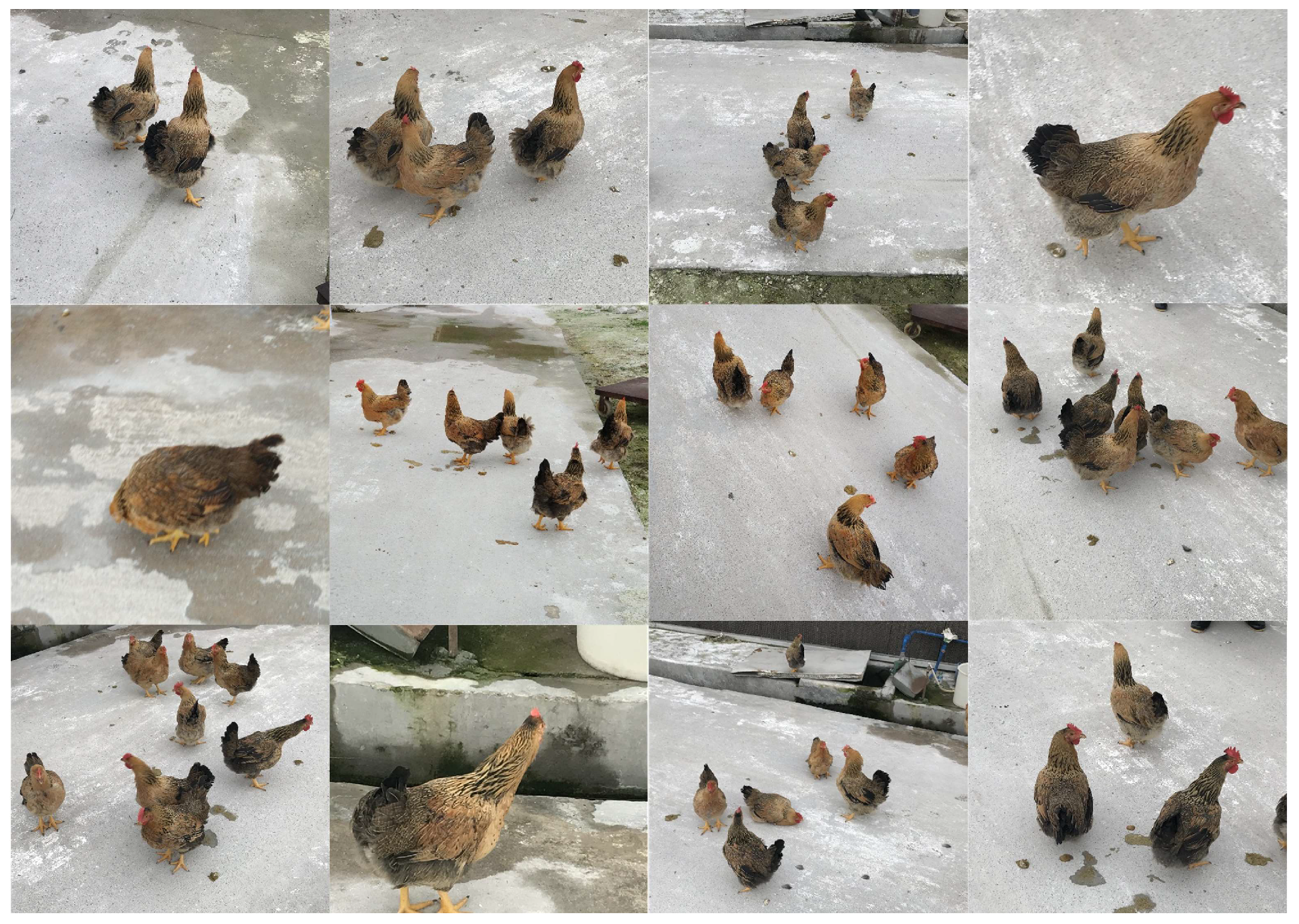



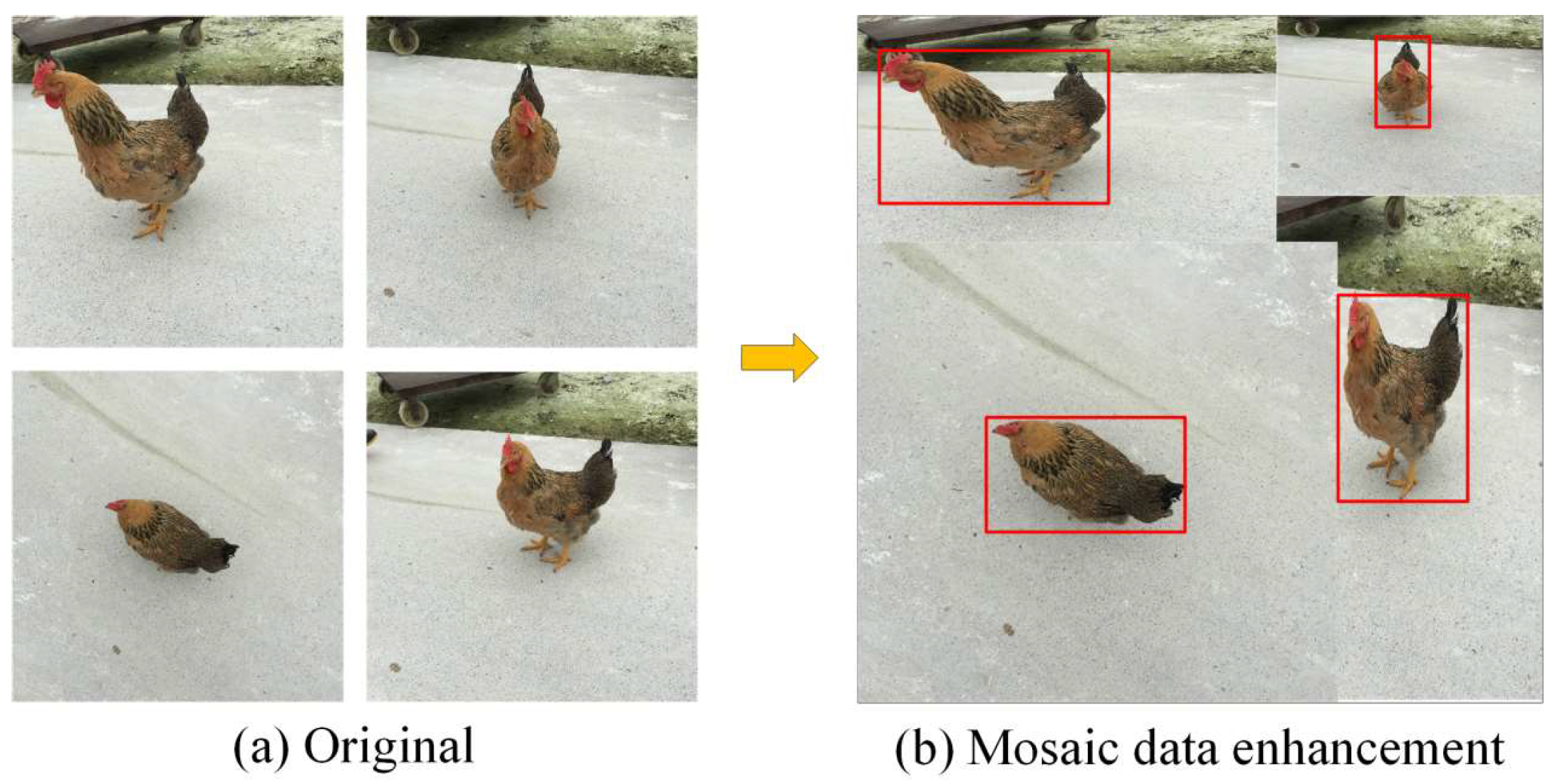
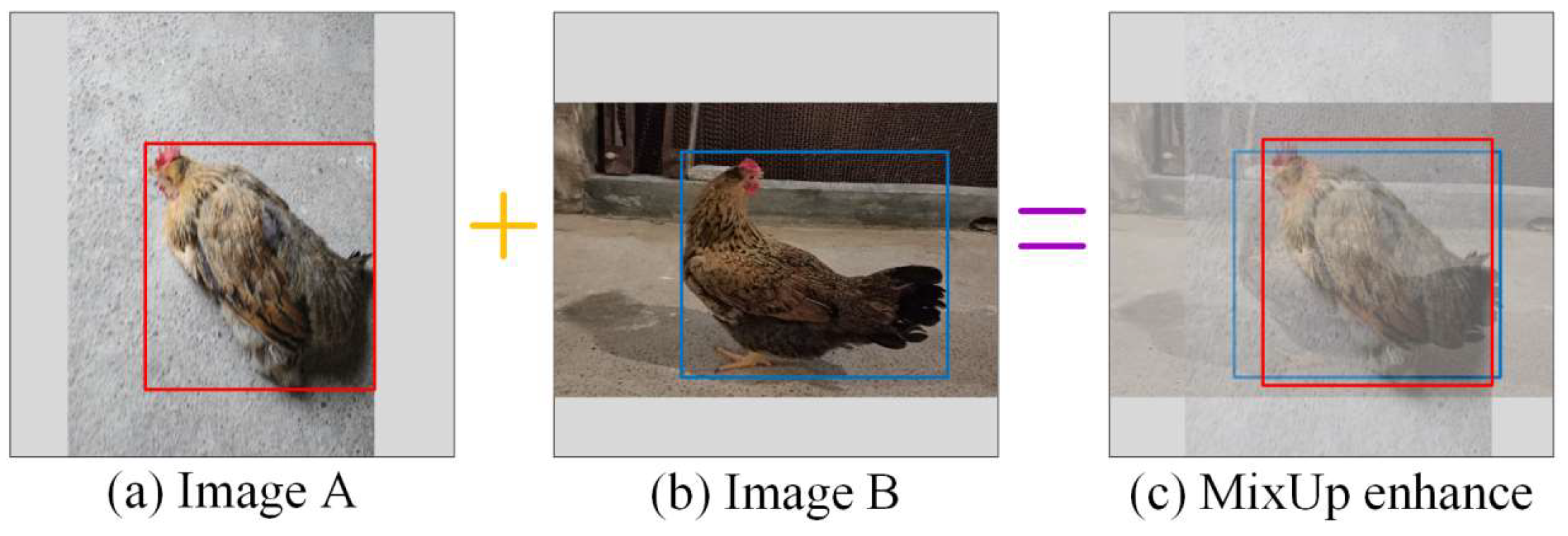
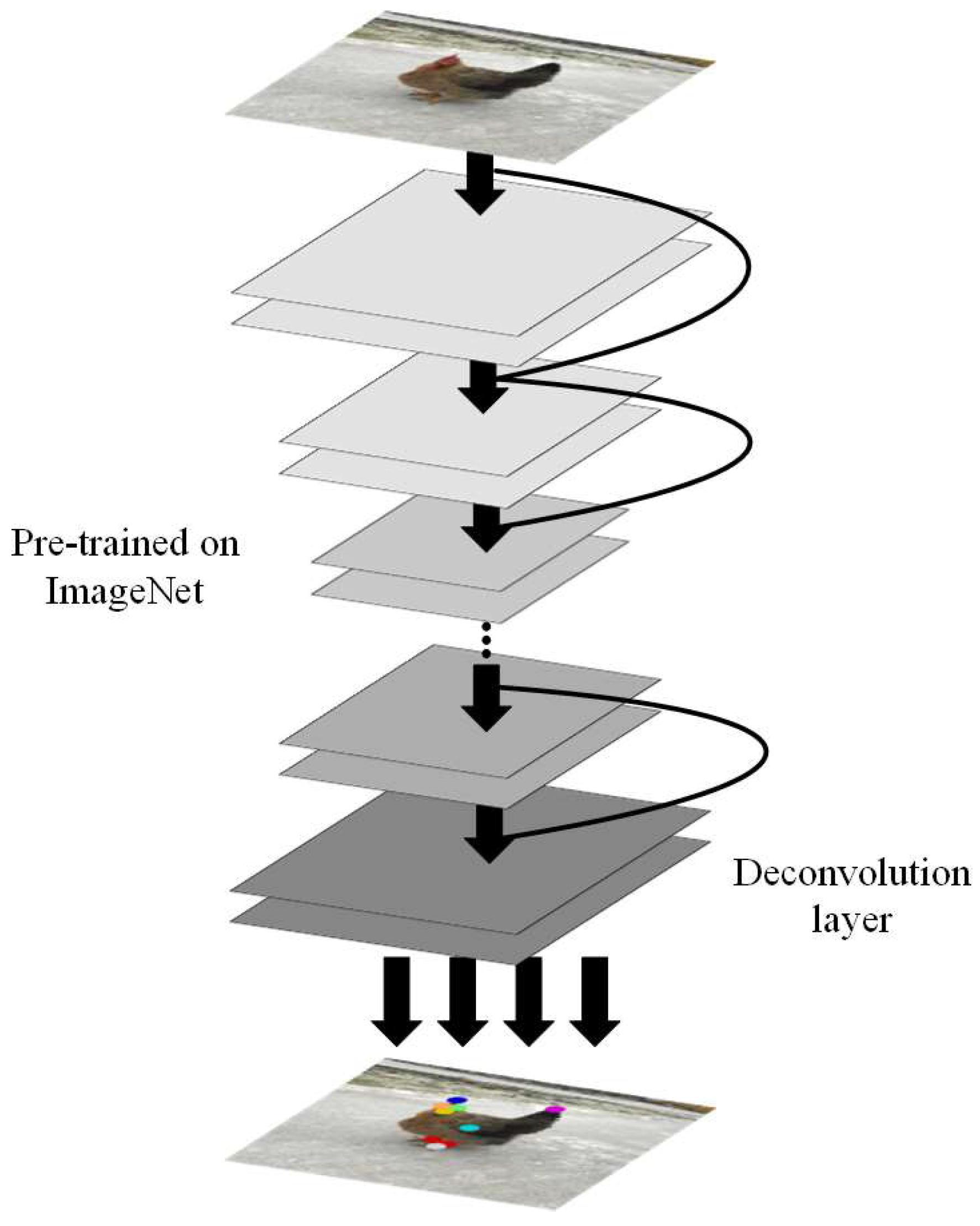
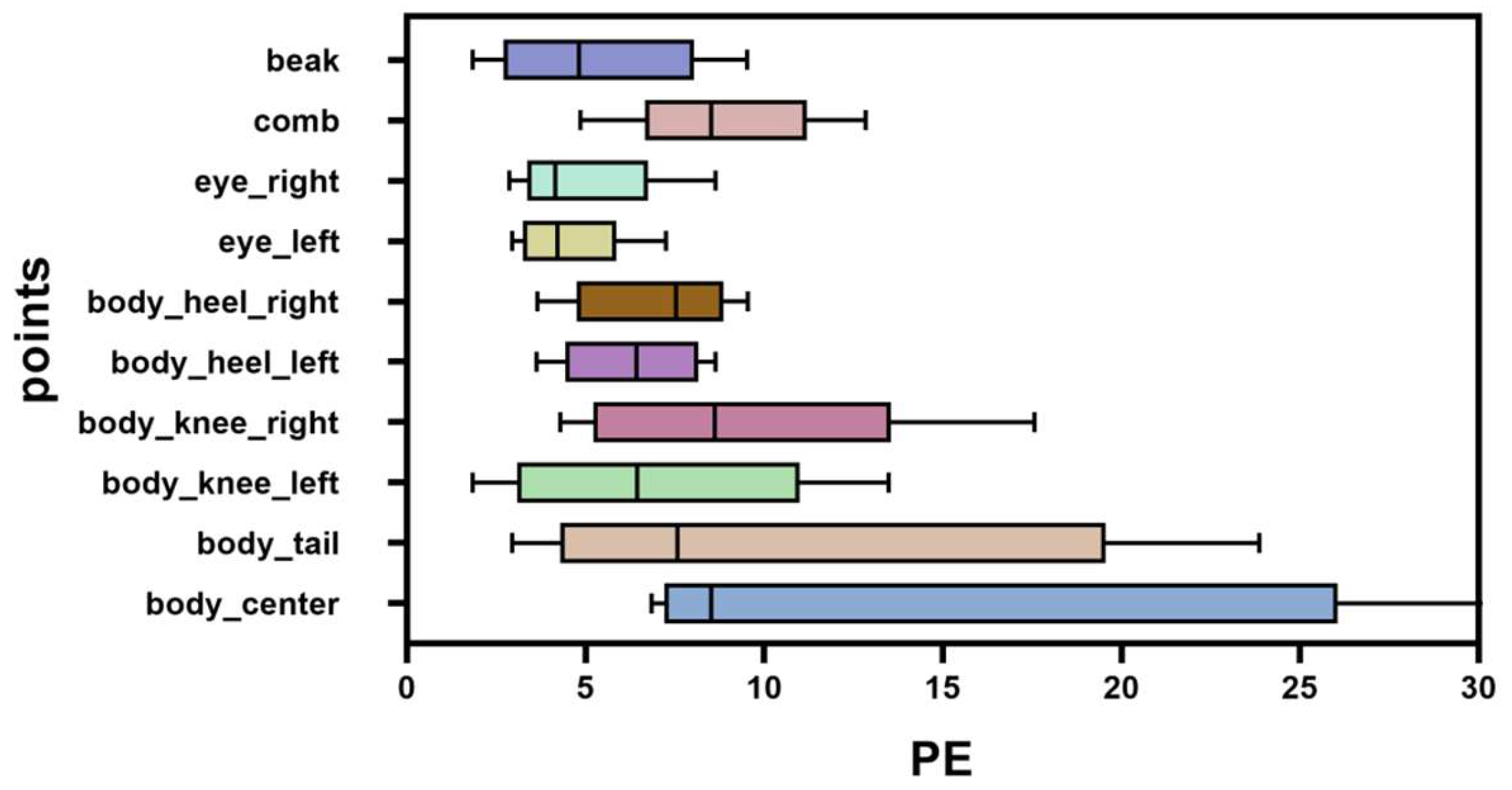
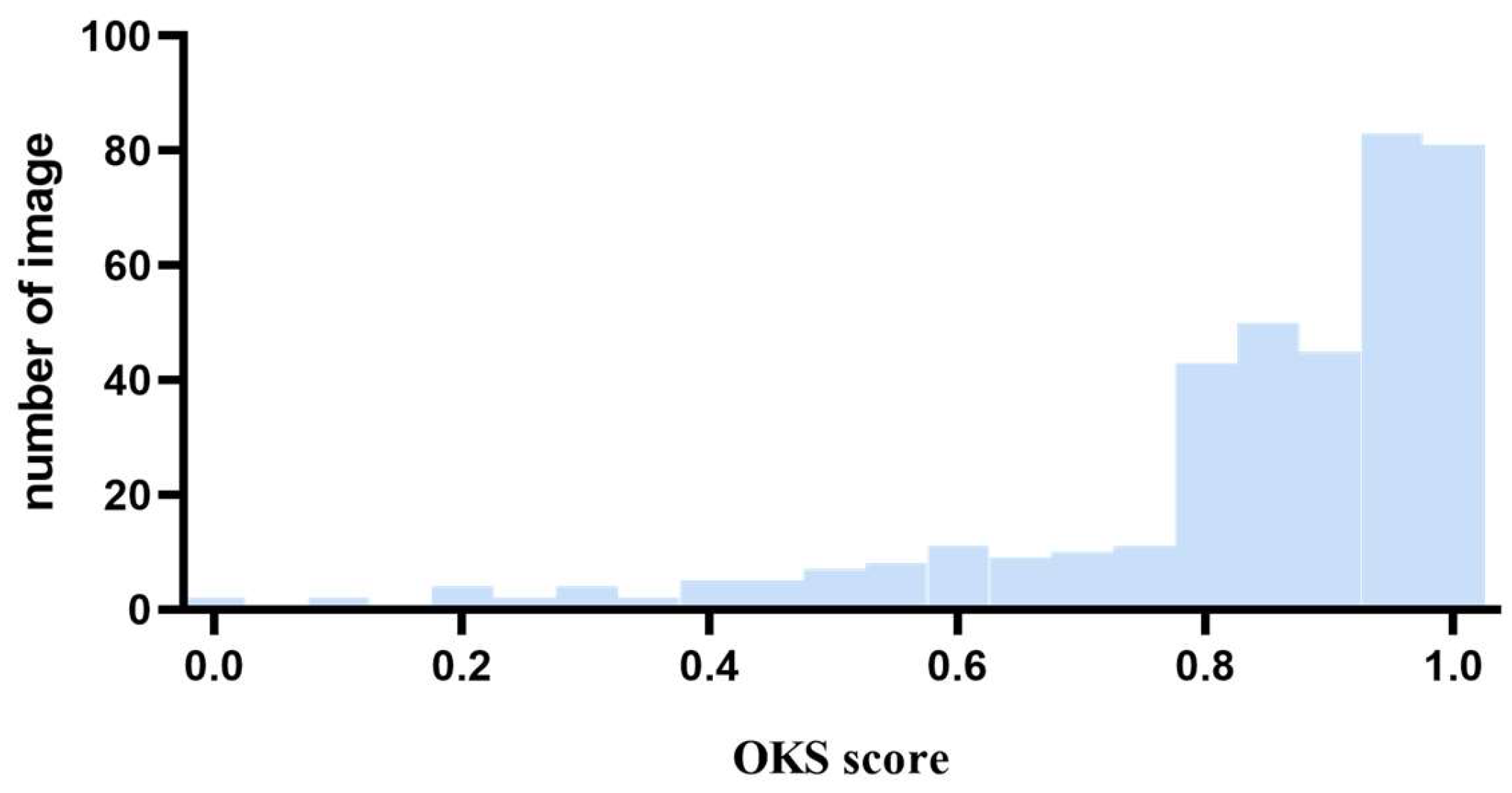
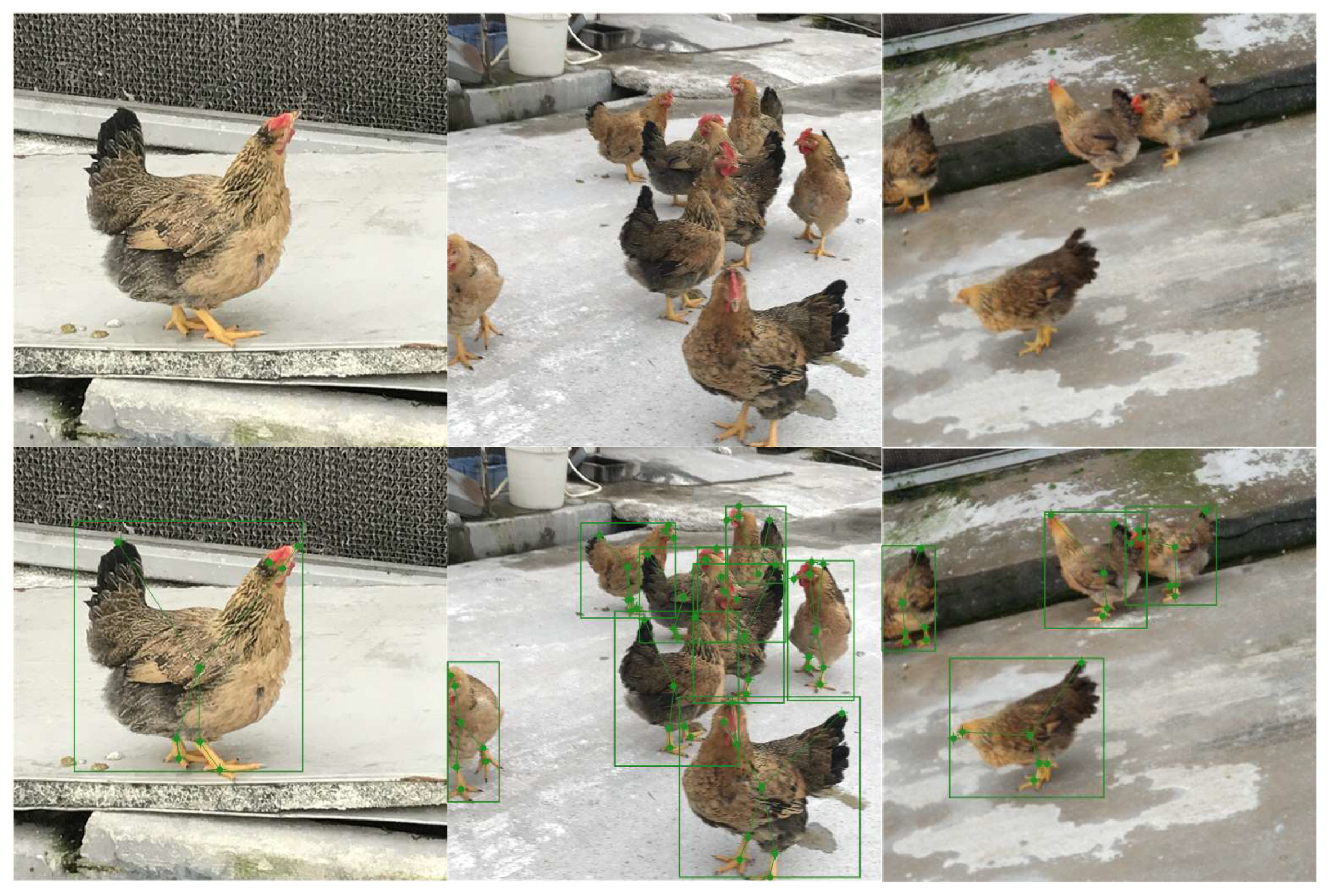
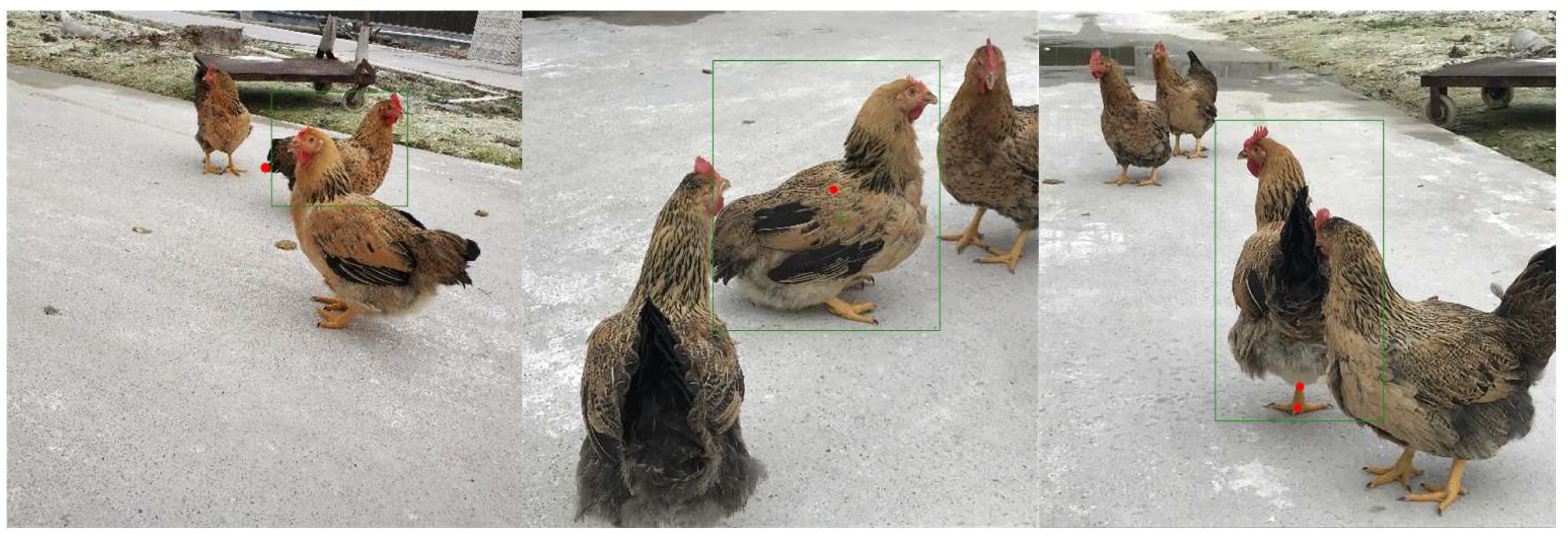
| Module | Object Detection | Pose Estimation |
|---|---|---|
| Input size | 640 × 640 | 512 × 512 |
| Batch size | 4 | 4 |
| Epoch | 300 | 200 |
| Learning rate | 1 × 10−3 | 1 × 10−3 |
| Optimizer | SGD | Adam |
| Algorithm | mAP | mAR | PCK | Speed (FPS) |
|---|---|---|---|---|
| YOLOX + EfficientNet | 0.601 | 0.727 | 0.771 | 20.46 |
| YOLOX-M + EfficientNet | 0.604 | 0.705 | 0.797 | 20.80 |
| YOLOX-S + EfficientNet | 0.652 | 0.742 | 0.789 | 22.16 |
| Keypoint | Training Set | Verification Set | Test Set |
|---|---|---|---|
| body_center | 6.84 | 8.52 | 25.76 |
| body_tail | 5.64 | 7.56 | 23.85 |
| body_knee_left | 4.32 | 6.44 | 13.48 |
| body_knee_right | 4.29 | 6.15 | 17.56 |
| body_heel_left | 3.62 | 6.42 | 7.68 |
| body_heel_right | 3.64 | 5.86 | 8.15 |
| eye_left | 2.94 | 3.54 | 4.45 |
| eye_right | 2.87 | 4.15 | 4.86 |
| comb | 4.85 | 8.52 | 12.84 |
| beak | 1.84 | 4.81 | 6.54 |
| Average | 5.31 | 7.56 | 17.30 |
Disclaimer/Publisher’s Note: The statements, opinions and data contained in all publications are solely those of the individual author(s) and contributor(s) and not of MDPI and/or the editor(s). MDPI and/or the editor(s) disclaim responsibility for any injury to people or property resulting from any ideas, methods, instructions or products referred to in the content. |
© 2024 by the authors. Licensee MDPI, Basel, Switzerland. This article is an open access article distributed under the terms and conditions of the Creative Commons Attribution (CC BY) license (https://creativecommons.org/licenses/by/4.0/).
Share and Cite
Fang, C.; Wu, Z.; Zheng, H.; Yang, J.; Ma, C.; Zhang, T. MCP: Multi-Chicken Pose Estimation Based on Transfer Learning. Animals 2024, 14, 1774. https://doi.org/10.3390/ani14121774
Fang C, Wu Z, Zheng H, Yang J, Ma C, Zhang T. MCP: Multi-Chicken Pose Estimation Based on Transfer Learning. Animals. 2024; 14(12):1774. https://doi.org/10.3390/ani14121774
Chicago/Turabian StyleFang, Cheng, Zhenlong Wu, Haikun Zheng, Jikang Yang, Chuang Ma, and Tiemin Zhang. 2024. "MCP: Multi-Chicken Pose Estimation Based on Transfer Learning" Animals 14, no. 12: 1774. https://doi.org/10.3390/ani14121774
APA StyleFang, C., Wu, Z., Zheng, H., Yang, J., Ma, C., & Zhang, T. (2024). MCP: Multi-Chicken Pose Estimation Based on Transfer Learning. Animals, 14(12), 1774. https://doi.org/10.3390/ani14121774











